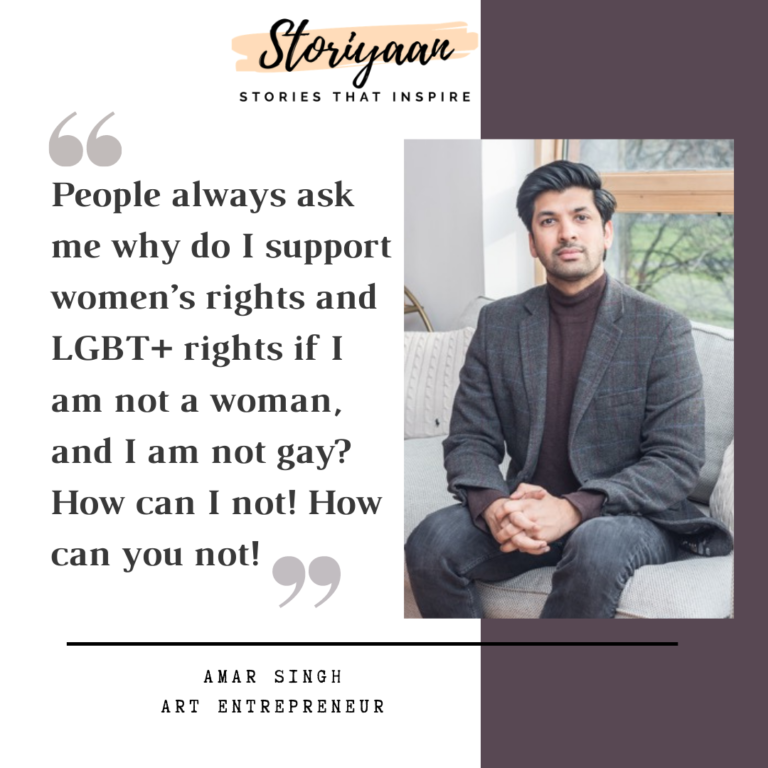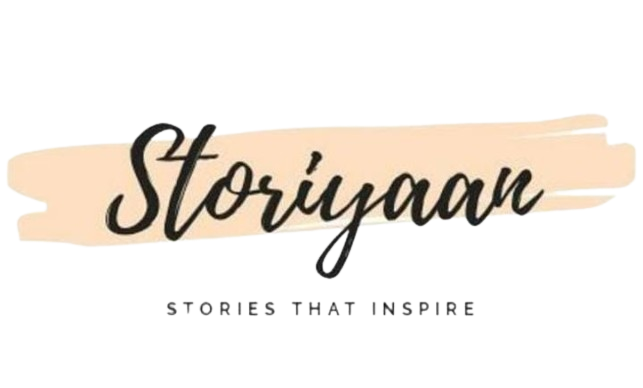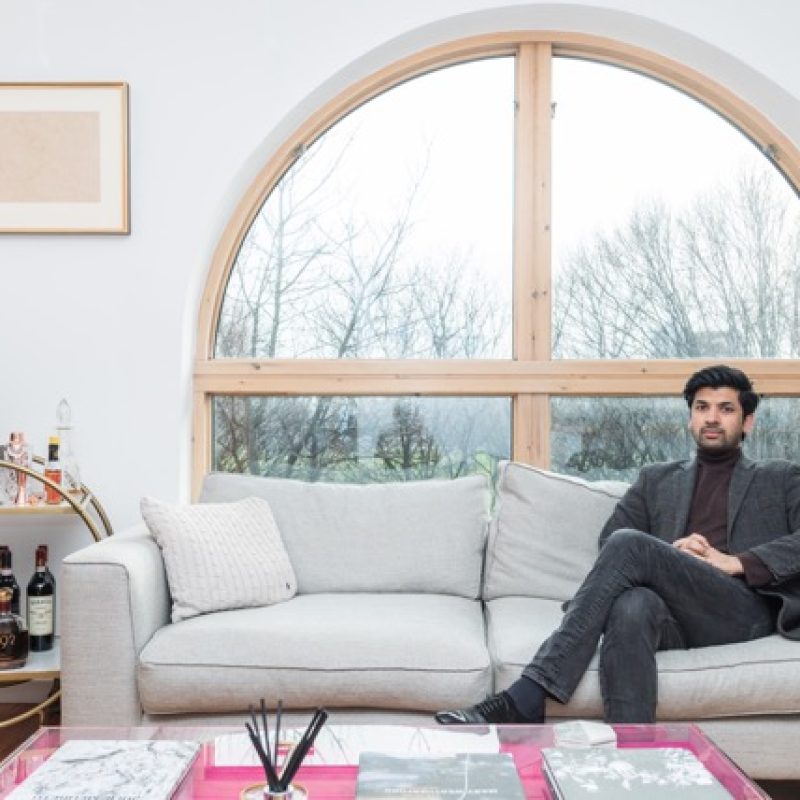Amar Singh is the director of the Amar Gallery, one of London’s hottest art galleries. He is a patron of the Tate, Serpentine, Whitechapel Gallery, and sits on LACMA’s collector’s committee. He has been involved with art since 2010.
Known for representing female and LGBTQI artists in his gallery, Amar is also an activist and champion of Women’s and LGBTQI Rights. He also made it to Forbes’ list of 30 Under 30. Team Storiyaan had the phenomenal opportunity of speaking to the art-enthusiast about his inspiration behind his work and what more is to come.

Interview
Questions and answers
We know you as a human rights activist. Talk to us about the events that molded you into this person.
I was raised in an environment that had a strong dedication to social justice. From a young age, my family instilled in me the mission of doing something about what isn’t right. My grandmother was an educator in India and spoke alongside Nehru and Gandhi about the importance of education, especially women’s education. My grandmother only passed away in 2017. She always spurred me on to make a positive difference in the world. From my mother to Rajkumari Amrit Kaur, there are strong feminists in my family. They have always fought for equality.
Can you express what makes you so passionate about art? Has art always been this important to you, or did it announce itself out of the blue?
Art is essential. It has always been important. The art world, however, is not. I have always been passionate about art, and so is everybody, even if they don’t realize it. Have you ever been to a person’s home without even a poster or a family photo on the walls? That is art, in its rawest and often most meaningful form. Luckily from a young age, social justice was not the only value my family exposed me to. As a family, we were always visiting museums and art studios. When I was thirteen, my parents took me to S.H. Raza’s studio in the south of France. We would sit and eat with him. He is now considered one of the most important Indian painters in history.
Why do you think gallery owners put male artists on a pedestal above female artists? Or is it the society that holds this spectacle?
It is because of the system, the anarchic, misogynistic, and patriarchal system which needs to be still dismantled. People always ask me why do I support women’s rights and LGBT+ rights if I am not a woman, and I am not gay? How can I not! How can you not! It is essential to care about other people. It is important to uplift other people. It is important to help other people, especially groups who are suppressed.
Tell us what made you contribute to shedding light on female artists.
Female artists are incredible. Patriarchal systems around the world have stopped women from entering museum collections, private collections, and public spaces. In 2018, I did an exhibition with the eminent American educator John Paul Rollert entitled ‘Hiding in Plain Sight,’ where we showcased the work of female abstract expressionists from the 1950s & 60’s New York. These were legends who invented new modes of art and painted alongside Jackson Pollock, Willem De Kooning & Mark Rothko. But because of being female, they were never paid the respect they deserved.
From Amar Singh Gallery to Curated, you seem to expand your endeavor to showcase the works of female artists. Would you soon like to showcase an exhibition only by LGBTQI artists?
My next exhibition is an LGBT+ exhibition. It is an online exhibition, Section 377, launching September 6th to celebrate the second anniversary of homosexual relations being legalized in India. This is a photographic exhibition in collaboration with Getty Images to highlight the journey and struggle for LGBT+ rights in the world’s largest democracy. It is also an online protest because the fight for LGBT+ rights is far from over. Same-sex couples cannot marry; same-sex couples cannot adopt, and LGBT+ conversion therapy centers are still legal across India.
It's well known that you're drawn towards abstract and contemporary art. What gravitates you to them?
I started my work in the art world with Renaissance drawings. You can still purchase for reasonable prices at auctions and low profile galleries. My passion exploded when I started working with artists who were alive or from the previous generation. For me, it is working with living legends, and that is still remarkable. Guerrilla Girls, Renee Cox, Judith Godwin, Mary Abbott, to name a few of the incredible artists I’ve worked and interacted with. It truly is such an honor.
Why do you think that the world of art is drawing its last ounce of breath?
Because they need to break real ground. They should start joining forces with movements such as Black Lives Matter, Me Too & Times Up to champion art, which can genuinely change the world. We do not need to see another plant painted by a young & rich white man sell for millions of dollars at auction.
How did you and Prince Manvendra ally decriminalizing gay-sex in India? What were the challenges faced by you?
Prince Manvendra is a true inspiration and a leading face of LGBT+ rights in India. I am also a writer and studied literature, so as a teenager, I reached out to Prince Manvendra regarding writing about him, and we became friends. He was very supportive of me and encouraged me, particularly as a straight person, to continue and grow my activism. Allys are often questioned, mainly by oppressing forces. Their voices, combined with members of the LGBT+ community, scare those in power. It makes them realize they should not be casting laws over love.
What is your approach to blending post-war historical art or contemporary artworks by only women?
I do not show art just because women do it – I show great art which happens to be by women. I do this due to gender imbalances in the art world. My goal is to keep growing my program. Once this virus is over, I will stage more exhibitions around the world to champion women and the LGBT+ community.
You recently spoke up about conversion therapy. How do you think we can mass propagate this in society?
Conversion Therapy centers are torture grounds, and they must be stopped. Millions of children and adults around the world are forced through these corrupt centers, which often use physical and mental abuse to influence a person’s sexual identity. Prince Manvendra himself was subjected to electroshock therapy for crying out loud. We can create change through petitions, campaigns at the grassroots and government levels. We can make donations to organizations actively working to stop these centers.
Is there an exhibit you worked on with an artist that stood out for you for some reason?
I work with the leading black feminist photographer alive: Renee Cox. She is a queen, and I exhibited her work in South Africa in 2018. One of the pieces which I put front and center was ‘Missy at Home,’ an image portraying a white housekeeper serving a powerful black woman. I’ve said it before, and I will repeat it for those who think there is something wrong with that image, there is something wrong with them. Let that sink in.
Quick 5
1. Favorite artwork The Wounded Table by Frida Kahlo, it has been missing for six decades
2. An underrated artist – Indian artist Parul Thacker
3. Describe Amar Gallery in one word – Justice
4. Picasso or Leonardo Da Vinci – Da Vinci
5. Charcoal sketches or Canvas painting – Charcoal sketches

